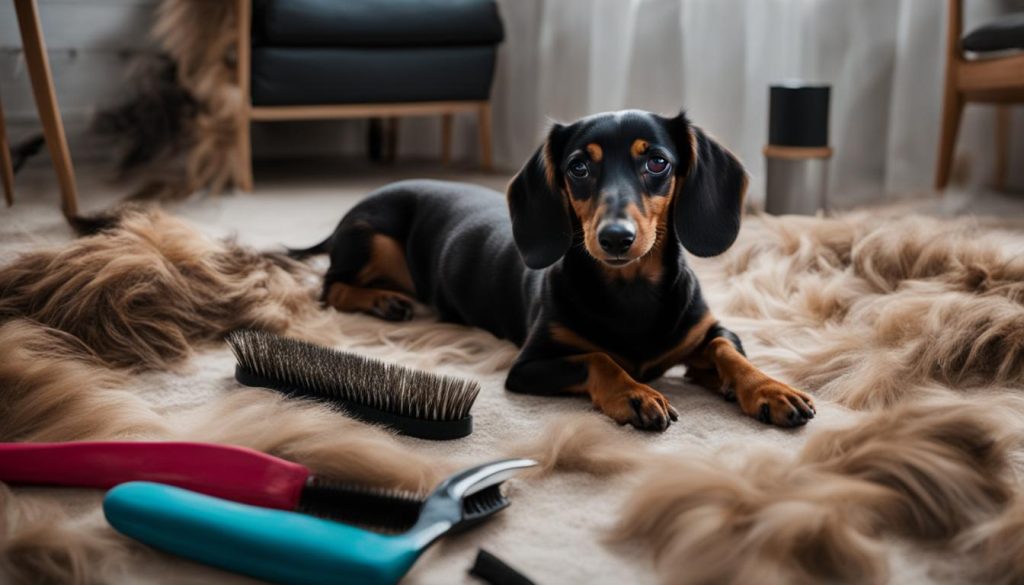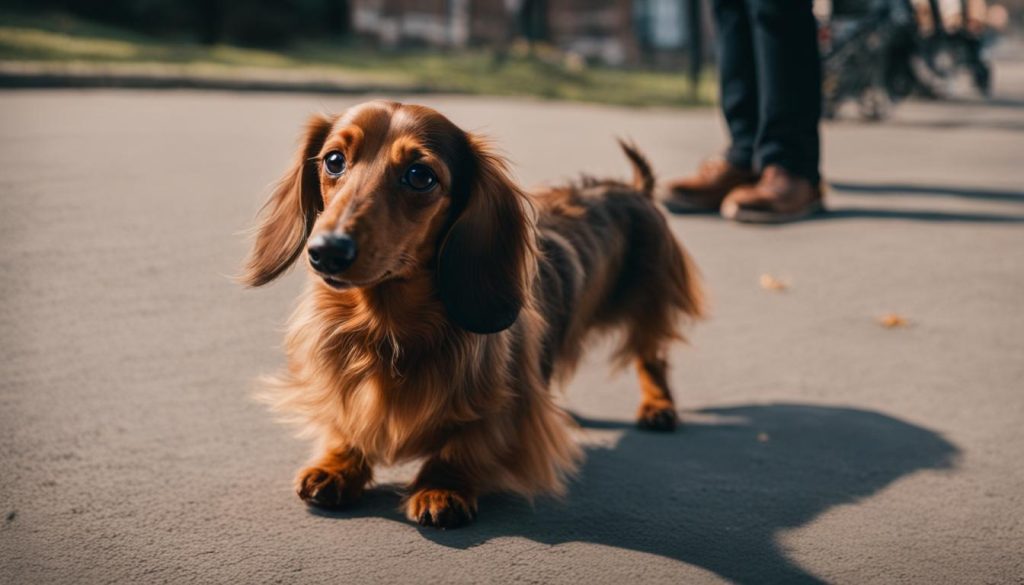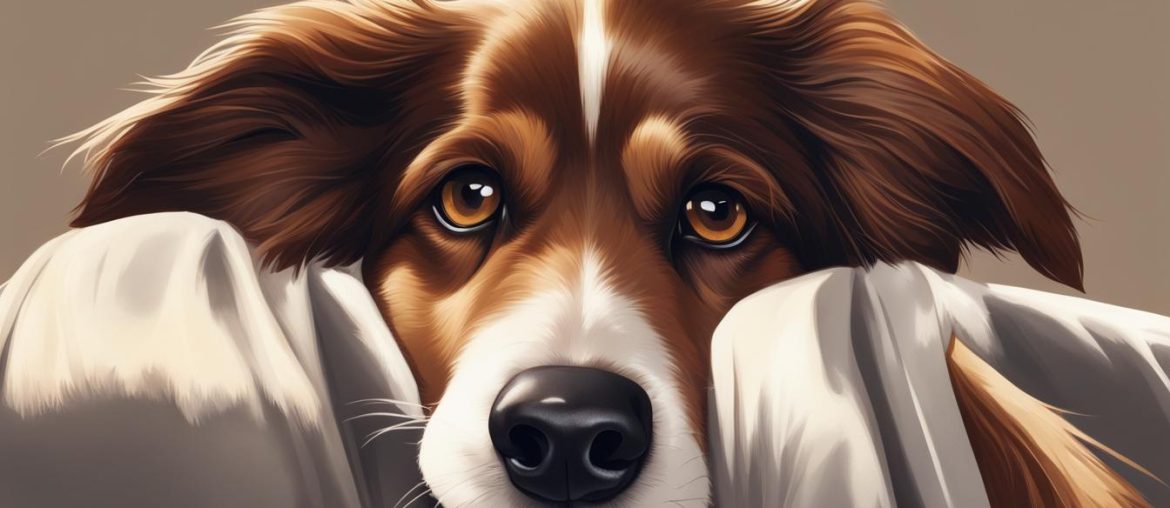Welcome to my comprehensive guide on shedding in dachshunds, also known as wiener dogs. If you’ve ever wondered whether these adorable little pups shed, you’ve come to the right place. In this article, I will provide you with all the information you need to understand the shedding habits of dachshunds and how to manage it effectively.
Before we delve into the details, let’s address the burning question: do dachshunds shed? The answer is yes, but the amount of shedding varies depending on the type of coat they have. Whether they have longhaired, smoothhaired, or wirehaired coats makes a difference in their shedding tendencies.
Shedding is a natural process for dachshunds, serving as a way to regulate body temperature and maintain the health of their skin and coat. Understanding their shedding patterns and implementing proper grooming techniques can help minimize the impact of shedding in your home.
Key Takeaways:
- Dachshunds do shed, but the amount of shedding varies depending on the coat type.
- Longhaired dachshunds shed the most, while smoothhaired dachshunds shed minimally.
- Wirehaired dachshunds shed the least and are a good option for those with allergies.
- Regular grooming and a balanced diet are important for managing shedding in dachshunds.
- Dachshunds are not hypoallergenic, but they may cause fewer allergic reactions compared to other breeds.
Shedding in Longhaired Dachshunds

Longhaired dachshunds possess a beautiful coat that requires regular maintenance to manage shedding effectively. These dachshunds have a dense undercoat and shed more prominently twice a year as the seasons change. To minimize shedding, it is crucial to establish a grooming routine that includes regular brushing and the use of specialized combs designed for their dense undercoats. By investing time in proper grooming, you can help moderate the shedding and keep your longhaired dachshund’s coat healthy and tangle-free.
| Grooming Tips for Longhaired Dachshunds |
|---|
| 1. Brush your dachshund’s coat at least once a week using a slicker brush or a comb with long, wide-spaced teeth to remove loose hairs and prevent matting.
2. Consider using a de-shedding comb specifically designed for longhaired dachshunds to efficiently remove excess hair. |
| 3. Utilize a detangling spray or conditioner during brushing sessions to ease the process and prevent discomfort for your dachshund.
4. Schedule regular visits to a professional groomer for assistance in maintaining your longhaired dachshund’s coat, especially during peak shedding seasons. 5. Be mindful of areas prone to matting, such as behind the ears and around the tail. Extra care should be taken when grooming these areas to prevent tangles. |
Effective grooming practices can significantly reduce shedding and keep your longhaired dachshund looking and feeling their best. By following these tips, you can manage shedding in your longhaired dachshund and maintain a healthy and lustrous coat.
Frequently Asked Questions
-
How often should I brush my longhaired dachshund?
Regular brushing is recommended at least once a week to remove loose hairs and prevent matting. However, during shedding seasons, more frequent brushing sessions may be necessary. -
Can grooming tools like de-shedding combs help reduce shedding in longhaired dachshunds?
Yes, de-shedding combs specifically designed for longhaired dachshunds can effectively remove excess hair and minimize shedding. Consult with a professional groomer for recommendations on suitable grooming tools for your dachshund. -
Should I take my longhaired dachshund to a professional groomer?
Regular visits to a professional groomer are beneficial, especially during shedding seasons. Groomers have the expertise and tools to handle the specific grooming needs of longhaired dachshunds and can help maintain their coats in optimal condition.
Shedding in Smoothhaired Dachshunds

Smoothhaired dachshunds are known for their minimal shedding compared to other coat types. Their short, sleek hairs make their shedding less noticeable, but it still requires some maintenance. Regular grooming is essential to help minimize shedding and keep their coat healthy.
Brushing smoothhaired dachshunds with a soft bristle brush helps to remove dead hair and distribute natural oils throughout the coat. This not only reduces shedding but also prevents matting and keeps the skin in good condition. Regular brushing sessions can also be a bonding experience between you and your furry friend.
In addition to brushing, proper nutrition plays a crucial role in preventing excessive shedding in smoothhaired dachshunds. A balanced diet that includes high-quality proteins, essential fatty acids, and vitamins helps promote a healthy coat. It’s important to consult with a veterinarian to determine the best diet for your dachshund’s specific needs.
Overall, smoothhaired dachshunds shed minimally, but regular grooming and a nutritious diet are still important to maintain their coat’s health and minimize shedding. With proper care, you can enjoy the company of your smoothhaired dachshund while keeping your home relatively free from excessive shedding.
Table: Grooming Tips for Smoothhaired Dachshunds
| Grooming Tip | Explanation |
|---|---|
| Regular brushing | Brushing with a soft bristle brush helps remove dead hair and distribute oils for a healthy coat. |
| Proper nutrition | A balanced diet with essential nutrients promotes a healthy coat and minimizes shedding. |
| Bathing | Regular baths using a mild dog shampoo help keep the coat clean and reduce shedding. |
| Professional grooming | Visiting a professional groomer for occasional trims and maintenance can help keep shedding under control. |
“Regular grooming is essential to keep smoothhaired dachshunds looking their best and to minimize shedding. Brushing and a nutrient-rich diet are key to maintaining a healthy, shiny coat.”
Shedding in Wirehaired Dachshunds

Wirehaired dachshunds are known for shedding the least among the different coat types. Their thick and wiry double coat helps regulate their body temperature and protects them from various weather conditions. Although wirehaired dachshunds shed less compared to other breeds, it’s still important to understand how to manage their shedding to keep their coat healthy and minimize hair loss.
Regular brushing is essential for wirehaired dachshunds to remove loose hairs and prevent matting. It’s recommended to use a slicker brush or a comb specifically designed for their wiry coat. This helps stimulate the skin and distribute natural oils, resulting in a healthier and less shedding-prone coat.
Another aspect of managing shedding in wirehaired dachshunds is professional grooming. Stripping, a grooming technique that involves manually pulling out dead hairs, is commonly used to maintain the texture and appearance of their coat. Regular visits to a professional groomer who specializes in wirehaired dachshunds can help keep their shedding under control.
Grooming Tips for Wirehaired Dachshunds
- Brush their coat at least once a week to remove loose hair and prevent matting.
- Consider using a slicker brush or a comb specifically designed for wirehaired dachshunds.
- Schedule regular visits to a professional groomer who understands the unique needs of wirehaired dachshunds.
- Discuss the option of stripping with your groomer to maintain the texture and appearance of their coat.
By following these grooming tips and techniques, you can effectively manage shedding in wirehaired dachshunds and keep their coat looking healthy and beautiful.
Factors Affecting Dachshund Shedding

When it comes to dachshund shedding, several factors can influence the amount of hair your furry friend leaves around the house. Understanding these factors can help you manage shedding and keep your dachshund’s coat healthy. Here are some key factors to consider:
Dachshund Health
The overall health of your dachshund plays a significant role in their shedding patterns. A healthy dachshund with a balanced diet and regular veterinary care is more likely to have a healthy coat and shed less. Stress, illness, and nutritional deficiencies can all contribute to excessive shedding, so it’s important to monitor your dachshund’s well-being and address any health issues promptly.
Dachshund Diet
The quality of your dachshund’s diet can also impact their shedding. A diet lacking essential nutrients can lead to poor coat quality and excessive shedding. Ensure that your dachshund is receiving a balanced and nutritious diet that supports their overall health, including the health of their skin and coat. Consult with your veterinarian to determine the best diet for your dachshund’s specific needs.
| Factors Affecting Dachshund Shedding | Description |
|---|---|
| Dachshund Health | Overall health, stress, illness, and nutritional deficiencies |
| Dachshund Diet | Quality and balance of the diet |
Grooming Practices
Proper grooming practices can greatly influence shedding in dachshunds. Regular brushing helps remove loose hair and prevents it from accumulating around the house. Additionally, bathing your dachshund with suitable products and frequency helps keep their coat clean and healthy, reducing excessive shedding. It’s essential to use grooming tools and techniques appropriate for your dachshund’s coat type, such as a de-shedding comb for longhaired dachshunds or a soft bristle brush for smoothhaired dachshunds.
Environmental Factors
The environment in which your dachshund lives can also impact shedding. Changes in temperature or season may trigger shedding cycles in dachshunds, particularly in longhaired and wirehaired varieties. Additionally, humidity levels and allergens in the environment can affect the health of your dachshund’s skin and coat. Maintaining a clean and comfortable living space for your dachshund can contribute to reduced shedding.
By considering these factors and implementing appropriate strategies, you can effectively manage and minimize shedding in your dachshund. Regular veterinary care, a healthy diet, proper grooming practices, and a suitable living environment all contribute to maintaining a healthy coat and a happy dachshund.
Tips for Managing Dachshund Shedding

Managing shedding in dachshunds is an important aspect of their grooming routine. By following a few simple tips, you can effectively reduce shedding and keep your dachshund’s coat healthy.
Regular Brushing
One of the most effective ways to manage dachshund shedding is through regular brushing. Use a brush or comb suitable for your dachshund’s coat type. For longhaired dachshunds, a slicker brush can help remove loose hairs and prevent matting. Smoothhaired dachshunds may benefit from a soft bristle brush, while wirehaired dachshunds may require regular stripping by a professional groomer to remove dead hair.
Bathing and Moisturizing
Bathing your dachshund regularly can help remove loose hairs and keep their coat clean. Use a gentle, dog-specific shampoo and conditioner to avoid drying out their skin. Moisturizing products, such as leave-in conditioners or coat sprays, can also help keep their skin and coat healthy, reducing excessive shedding.
Diet and Nutrition
A balanced diet is crucial for maintaining a healthy coat and reducing shedding. Ensure your dachshund’s diet is rich in essential nutrients, including omega-3 fatty acids, which promote healthy skin and coat. Consult with your veterinarian to determine the best diet for your dachshund’s specific needs.
By following these tips, you can effectively manage dachshund shedding and keep your furry friend looking and feeling their best.
Dachshunds and Hypoallergenic Qualities
Dachshunds are often sought after by individuals with allergies due to their reputation for being hypoallergenic. While no dog breed is completely allergen-free, dachshunds have certain qualities that make them potentially more suitable for allergy sufferers compared to other breeds.
One of the main factors that contribute to the hypoallergenic nature of dachshunds is their shedding patterns. Dachshunds, especially wirehaired dachshunds, tend to shed less compared to breeds with longer and denser coats. This reduced shedding results in fewer allergens being released into the environment, making it easier for individuals with allergies to tolerate their presence.
However, hypoallergenic qualities can vary among individuals. Some people with allergies may still experience reactions to dachshunds, while others may find that their symptoms are significantly reduced. It’s recommended to spend time with a specific dachshund to see if you have any allergic reactions before deciding to bring one into your home.
| Dachshund Mixes and Shedding | Shedding Level |
|---|---|
| Dachshund + Poodle | Low |
| Dachshund + Shih Tzu | Low to Moderate |
| Dachshund + Bichon Frise | Low to Moderate |
| Dachshund + Yorkshire Terrier | Low to Moderate |
If you’re specifically looking for a dachshund mix, you may find that certain mixes shed less compared to purebred dachshunds. For example, dachshund mixed with a poodle tends to have a low shedding level. However, it’s important to remember that the shedding level can still vary from individual to individual, even within the same mix.
To summarize, while dachshunds are not completely hypoallergenic, they may be a better choice for individuals with allergies compared to other breeds. Their lower shedding levels, especially in wirehaired dachshunds, can help reduce the presence of allergens in the environment. Remember to spend time with the specific dachshund or mix you’re considering to determine if you have any allergic reactions before making a decision.
Tips for Allergy Sufferers

If you have allergies and are considering a dachshund as a pet, it’s important to take certain precautions to minimize your exposure to allergens. Spending time with the specific dog you are considering can help determine if you have any allergic reactions. Additionally, there are several steps you can take to create a more allergy-friendly environment.
To reduce allergens in your home, regular cleaning is essential. Use a vacuum cleaner with a HEPA filter to effectively capture pet dander and other allergens. Consider using air purifiers with HEPA filters as well, especially in rooms where you spend a significant amount of time. These devices can help remove airborne allergens, providing relief from allergy symptoms.
Another strategy is to limit your dachshund’s access to certain areas of the house, such as the bedroom. Keeping the bedroom off-limits to your pet can help create a designated allergy-free space for rest and relaxation. Additionally, regularly washing your dachshund’s bedding can help remove accumulated dander and allergens.
Key Tips for Allergy Sufferers:
- Spending time with the specific dog before bringing them home
- Regular cleaning with a vacuum cleaner featuring a HEPA filter
- Using air purifiers with HEPA filters
- Limiting the dachshund’s access to certain areas of the house
- Regularly washing the dachshund’s bedding
By following these tips, you can create a more allergy-friendly environment and enjoy the companionship of a dachshund without excessive allergic reactions. While dachshunds are not hypoallergenic, taking these precautions can help minimize allergens and make living with a dachshund more comfortable for allergy sufferers.
Wrapping Up
Dachshunds, also known as weiner dogs, do shed, but the amount of shedding can vary depending on the coat type. Longhaired dachshunds tend to shed the most, while smoothhaired and wirehaired dachshunds shed less.
To manage shedding in dachshunds, regular grooming is essential. This includes brushing their coat using appropriate grooming tools, bathing them as needed, and visiting a professional groomer when necessary.
Although dachshunds are not considered hypoallergenic, they may be a suitable choice for individuals with allergies. Their lower shedding compared to other dog breeds may result in fewer allergic reactions. However, it is important for allergy sufferers to spend time with a dachshund to assess their own sensitivity before making a decision.
To summarize, while dachshunds do shed, proper care and maintenance can help minimize the shedding. With regular grooming, a balanced diet, and veterinary care, dachshund owners can ensure their furry companions have healthy skin and coats.
FAQ
Do Dachshunds shed?
Yes, Dachshunds do shed to some degree. The amount of shedding depends on the coat type, such as longhaired, smoothhaired, or wirehaired.
How much do longhaired Dachshunds shed?
Longhaired Dachshunds shed the most among the coat types. They have a dense undercoat and shed prominently twice a year with the changing seasons.
What can I do to manage shedding in longhaired Dachshunds?
Regular brushing and care with a comb designed for their dense undercoats can help moderate shedding. Grooming tools like a de-shedding comb can be beneficial in removing loose hairs and preventing mats in their fur.
How much do smoothhaired Dachshunds shed?
Smoothhaired Dachshunds shed minimally. Their shedding may not be as noticeable due to their tiny hairs.
How can I minimize shedding in smoothhaired Dachshunds?
Regular grooming, including brushing with a soft bristle brush, can help remove dead hair and distribute oils that keep the skin and coat healthy. This can help minimize shedding in smoothhaired Dachshunds.
How much do wirehaired Dachshunds shed?
Wirehaired Dachshunds shed the least among the coat types. They have a thick undercoat that helps regulate their body temperature.
What can I do to manage shedding in wirehaired Dachshunds?
Regular brushing, stripping by a groomer, and proper grooming can help manage shedding in wirehaired Dachshunds.
What factors can affect Dachshund shedding?
Factors such as the health of the Dachshund, including stress, illness, or nutritional deficiencies, can influence shedding.
How can I manage shedding in Dachshunds?
Regular grooming, including brushing, bathing, and visiting a groomer when necessary, can help reduce shedding. Maintaining a healthy, balanced diet and regular veterinary check-ups are also important.
Are Dachshunds hypoallergenic?
No, Dachshunds are not considered hypoallergenic. However, some individuals with allergies may find that Dachshunds shed less and cause fewer allergic reactions compared to other breeds.
What tips do you have for allergy sufferers considering a Dachshund?
Spend time with the specific Dachshund to see if you have any allergic reactions. Keeping your home clean, using HEPA filters in vacuum cleaners, and using air purifiers can help reduce allergens in the environment. Limiting the Dachshund’s access to certain areas of the house can also minimize exposure to allergens.
Do Dachshunds shed?
Yes, Dachshunds do shed to some degree. The shedding amount varies among the different coat types.






